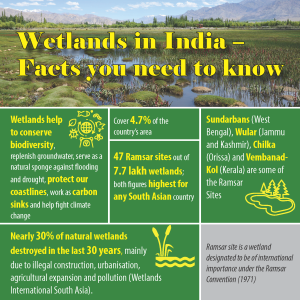World Wetlands Day: Protect Nature’s Nurseries

Think wetlands, and the image that comes to mind is that of a large lake filled with migratory birds. However, wetlands are more than just water bodies. They often support large numbers of aquatic and terrestrial animals as well as unique plants. They are also providers of nature-based solutions for local communities, besides offering several ecosystem services such as providing food, conserving water, and helping to combat climate change.
It is, therefore, fitting that World Wetlands Day 2022, which falls on February 2, is being commemorated globally with the theme ‘Wetlands Action for People and Nature’ to emphasize the urgent need to conserve and use them sustainably. The alarm bells have been ringing for several years, though. We have reportedly lost about 90% of the world’s wetlands since the 1700s, and they are disappearing three times faster than forests today. India, too, has lost nearly 30% of its wetlands – covering 4.7% of its area – in the last 30 years, to urbanization, deforestation, encroachments, and expansion of agriculture, among other factors.
The conservation of such biodiverse areas has been one of the key focus areas of ICLEI South Asia’s work in the subcontinent. Besides documenting natural capital, preparing geo-referenced maps, developing sustainable and climate-resilient planning strategies, undertaking restoration, developing investment cases, capacity building, and training of local authorities and communities, we have started work on conserving coastal wetlands such as in Goa (with a focus on khazans), and in Kochi, which is located near Vembanad Lake, the largest Ramsar wetland site in India. Wetland restoration also forms part of the high-altitude grassland restoration plan that is being developed by ICLEI South Asia for the Himalayan pasturelands in Himachal Pradesh. The need to raise political and public awareness about wetlands is urgent, in order to encourage more similar action to conserve them.



